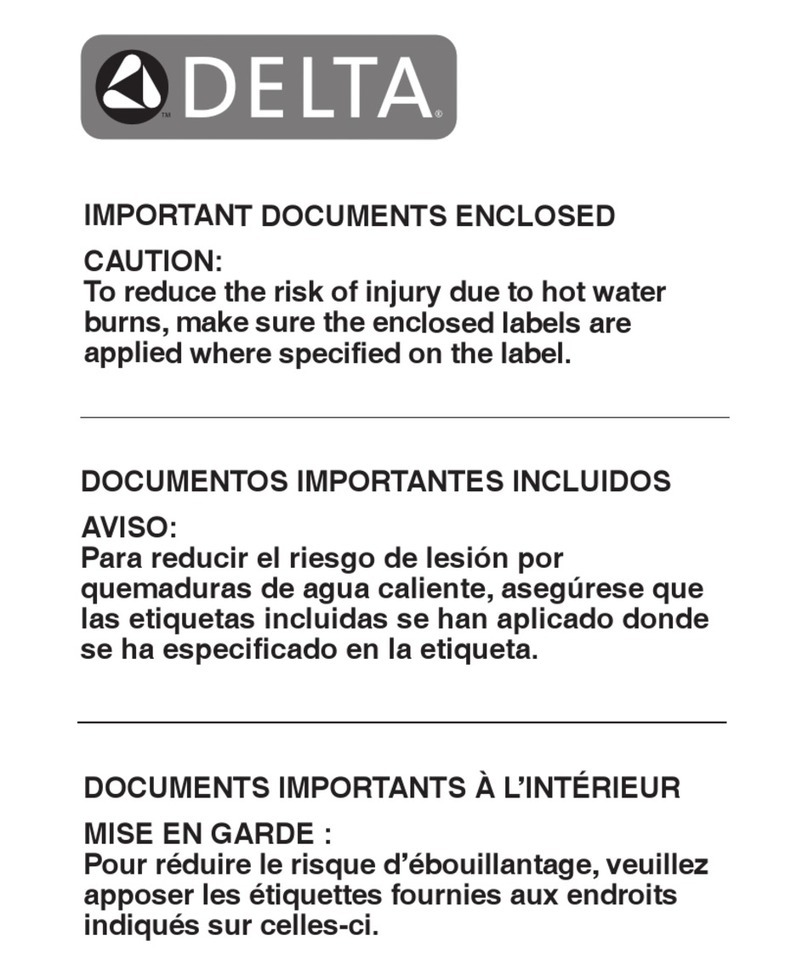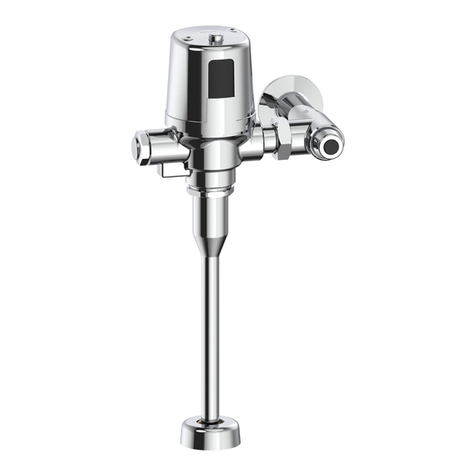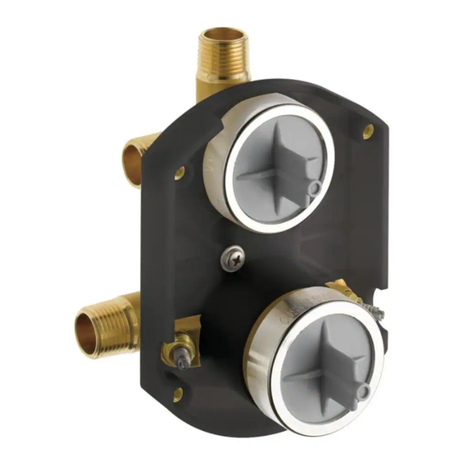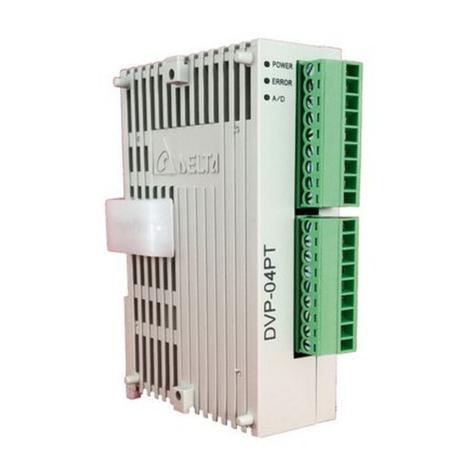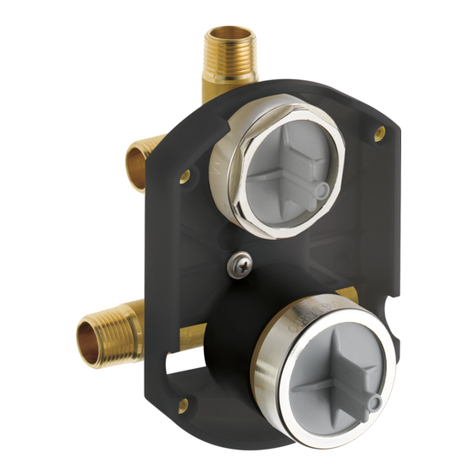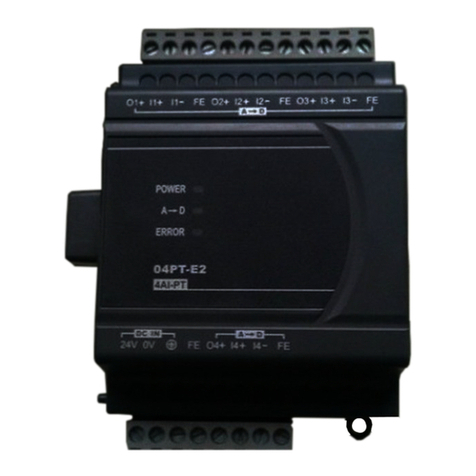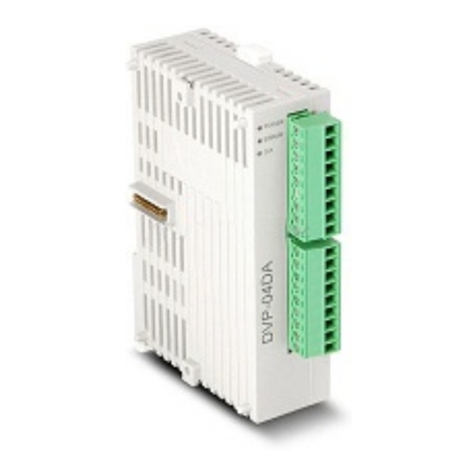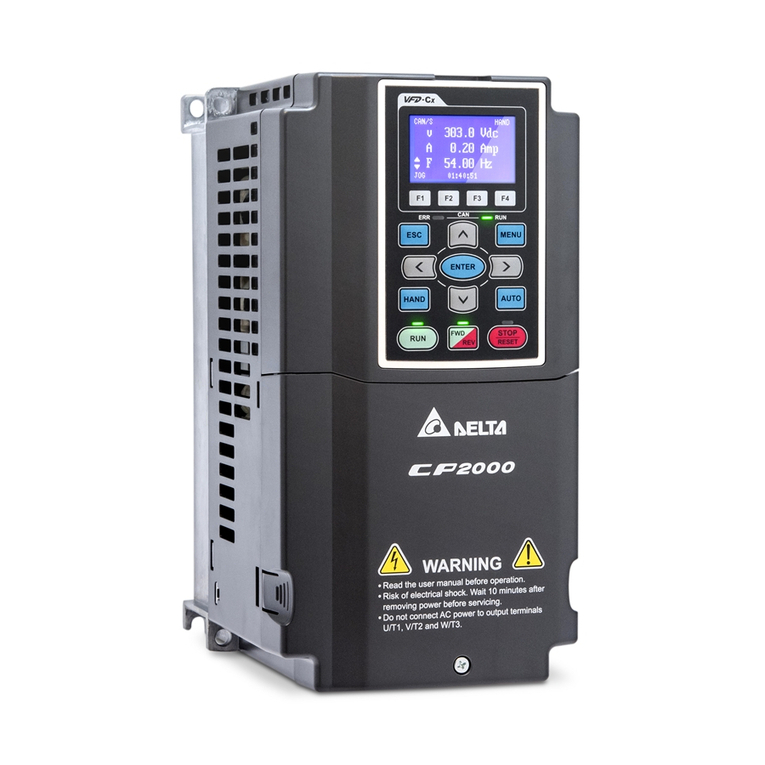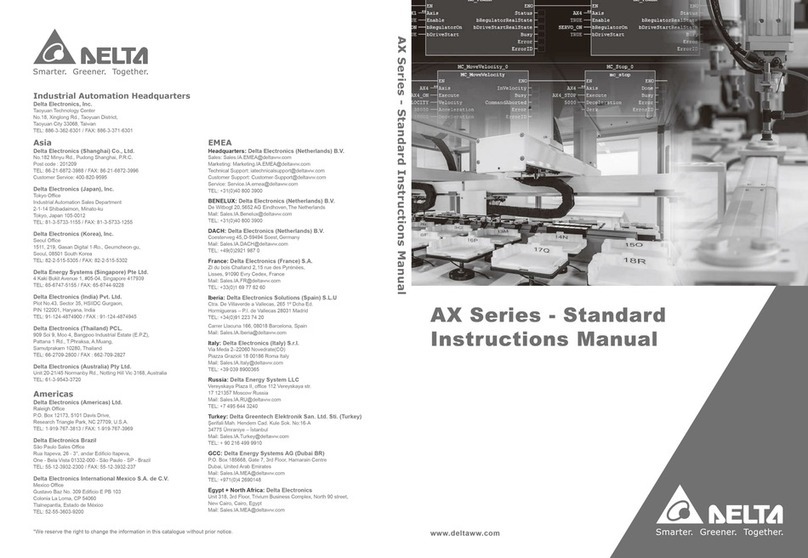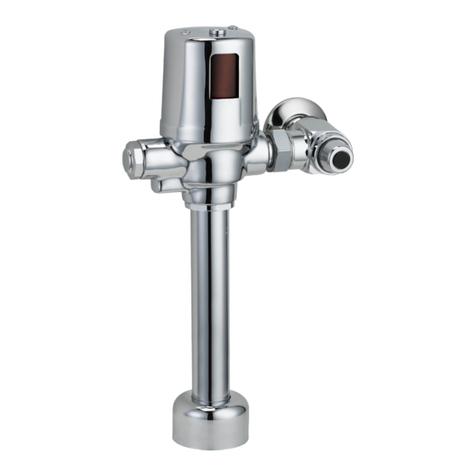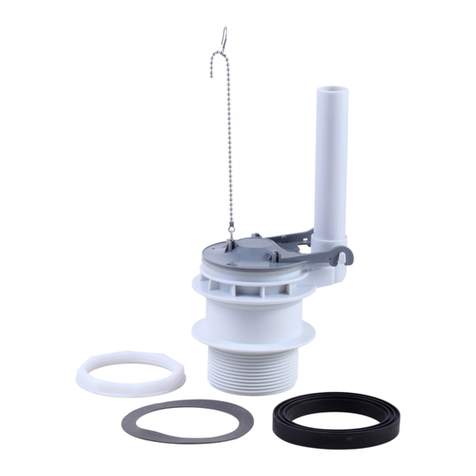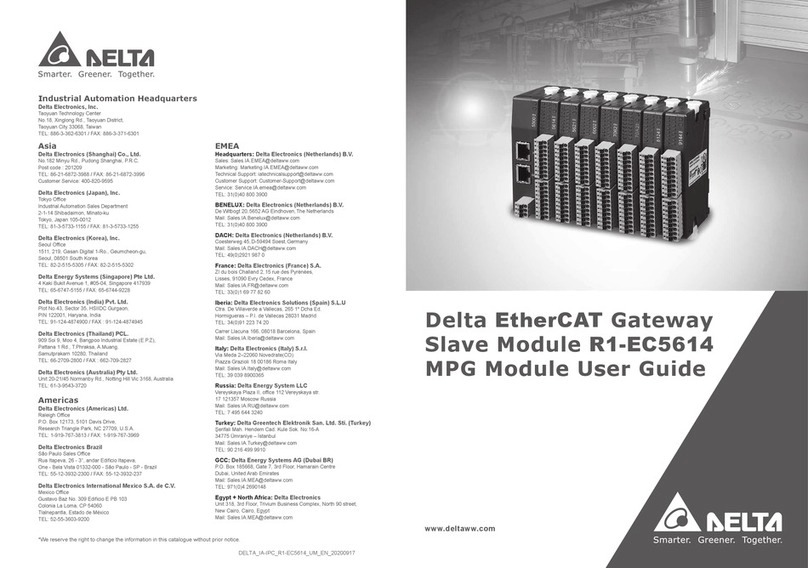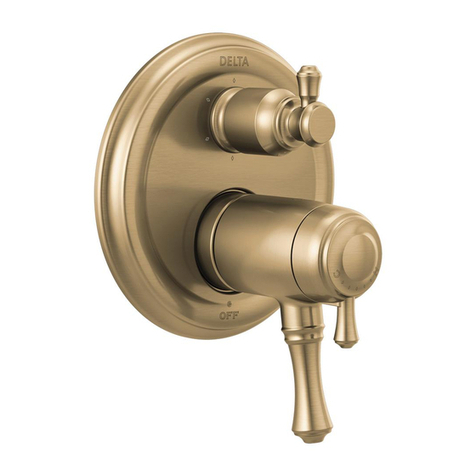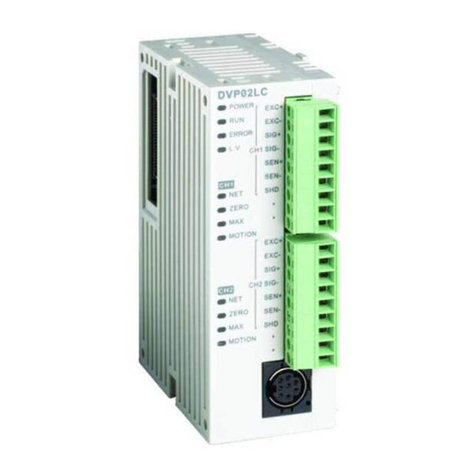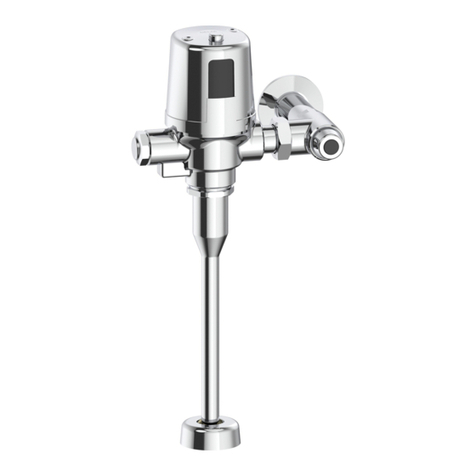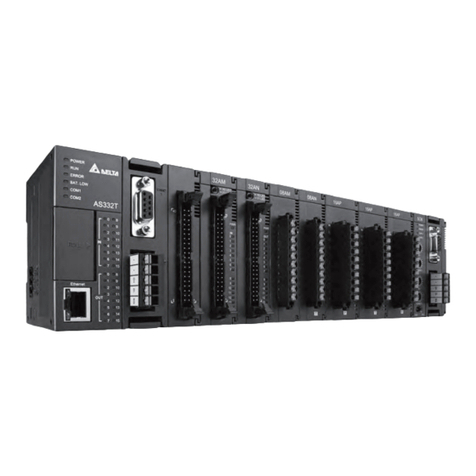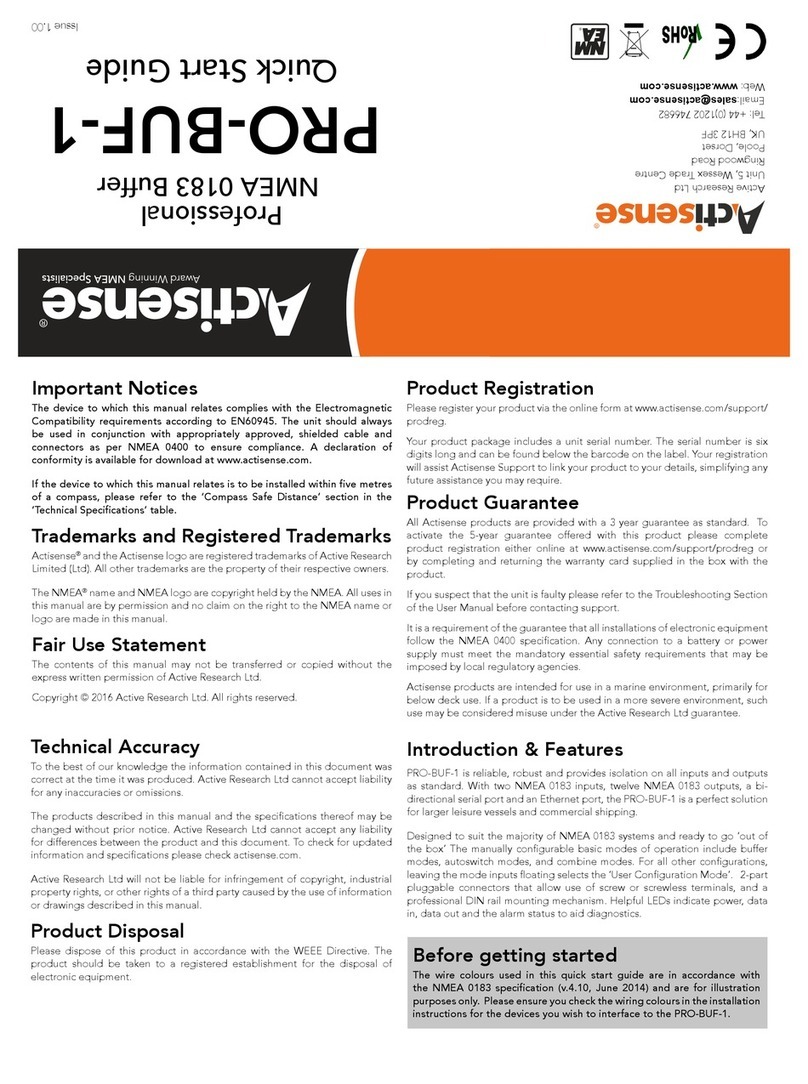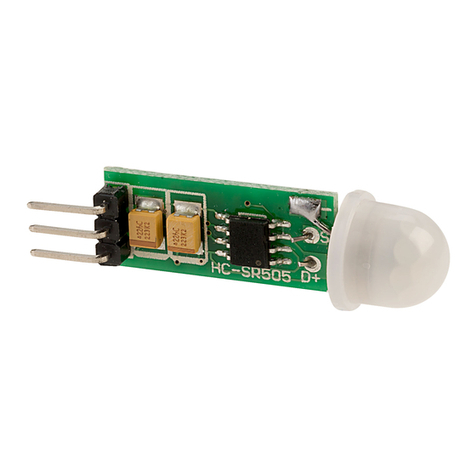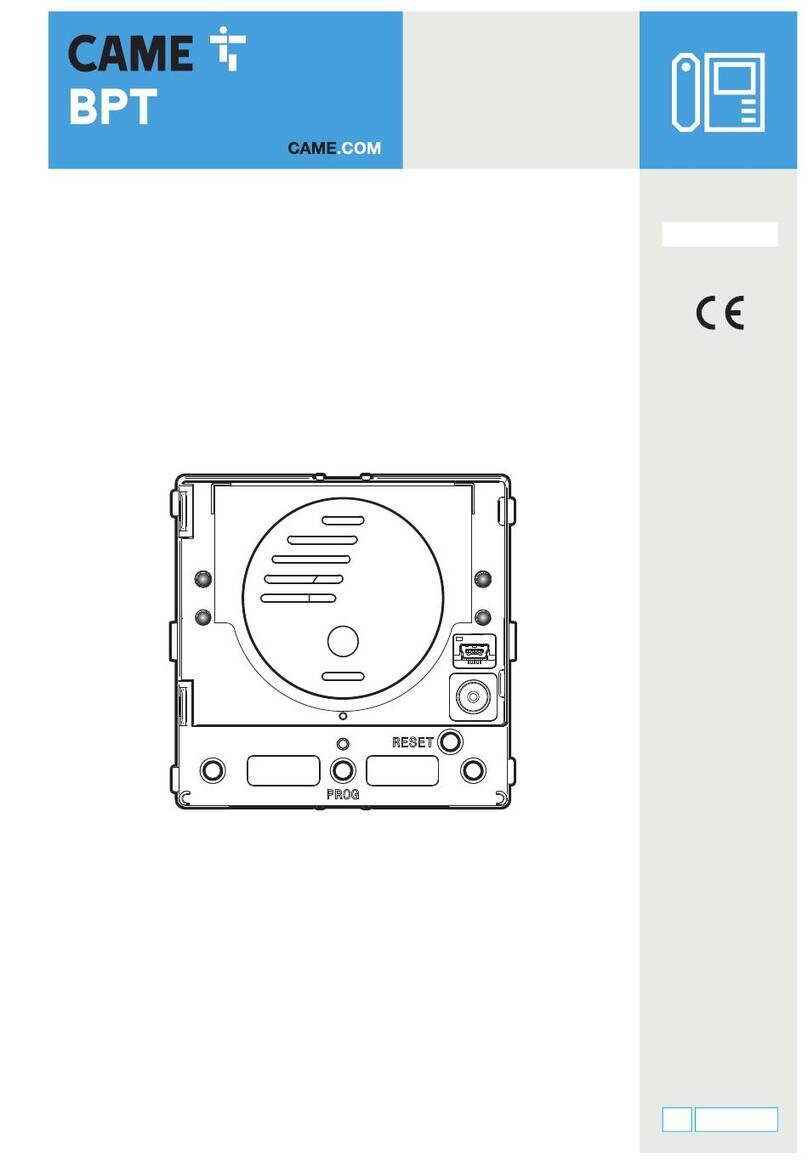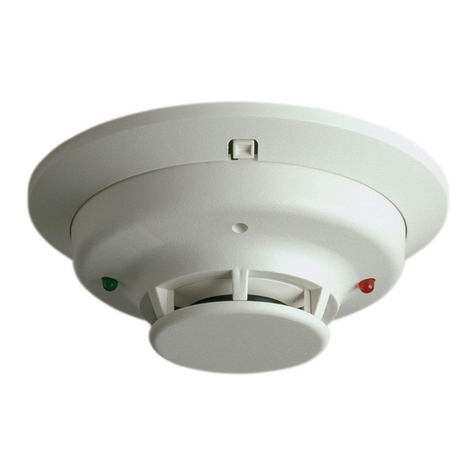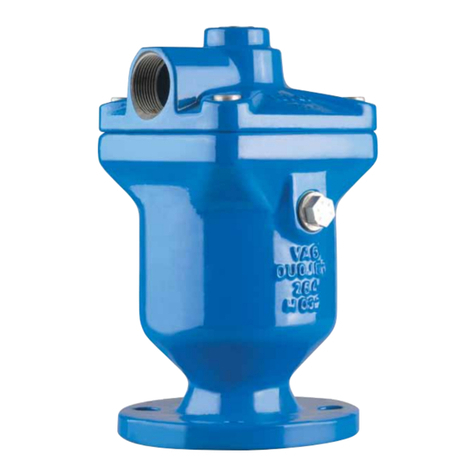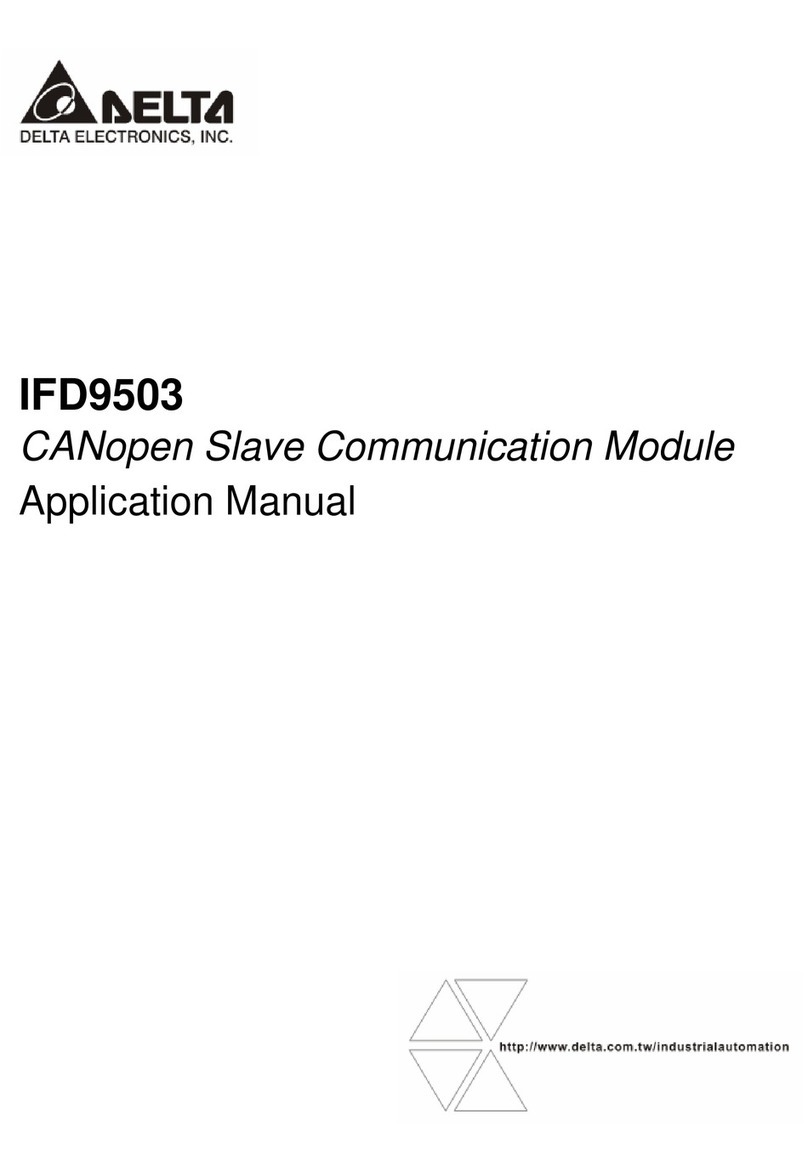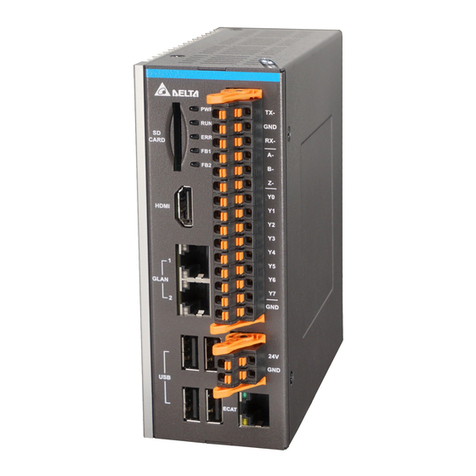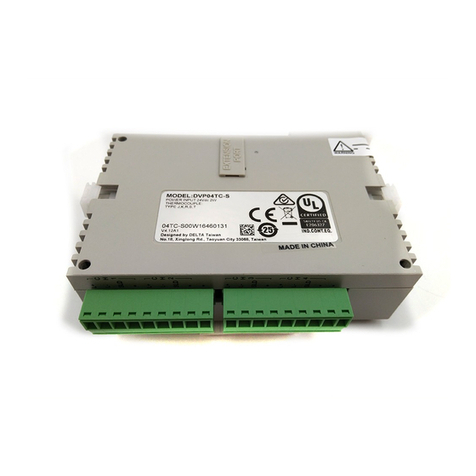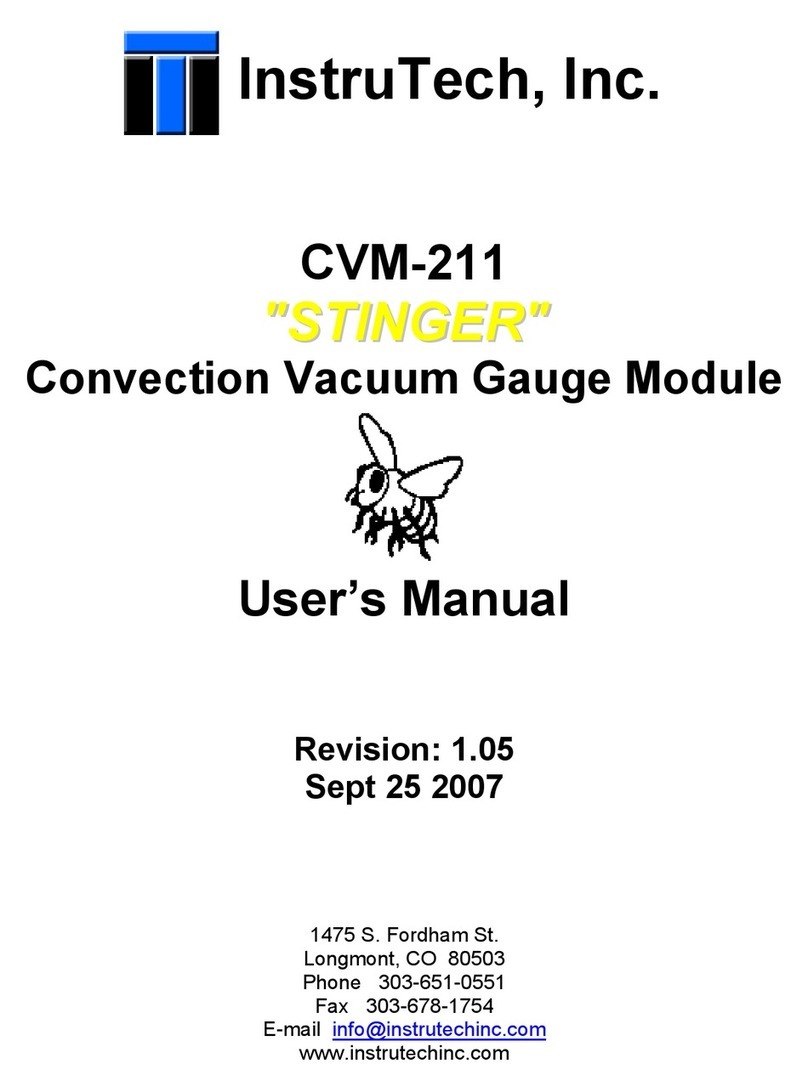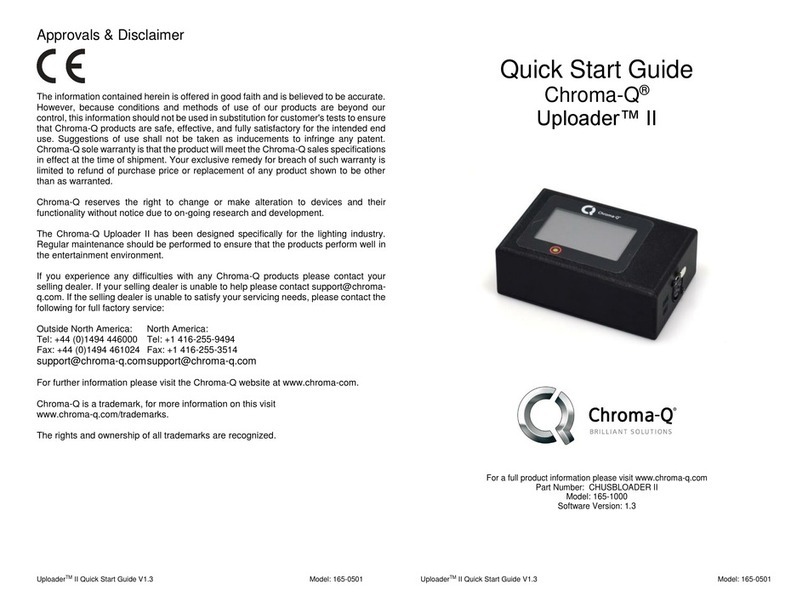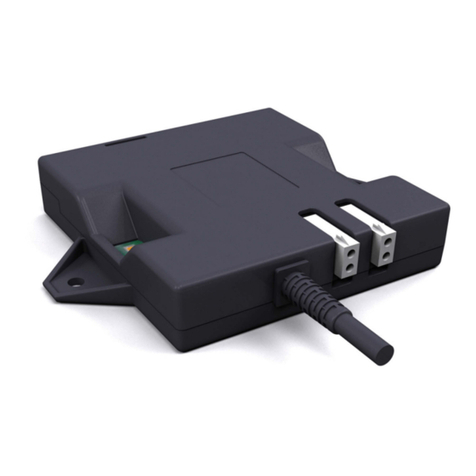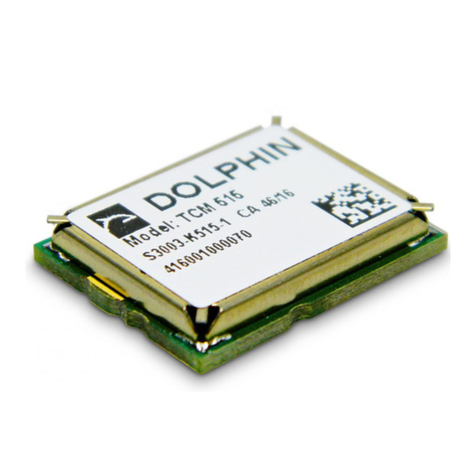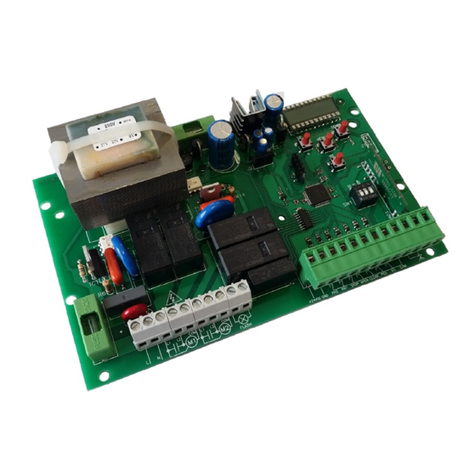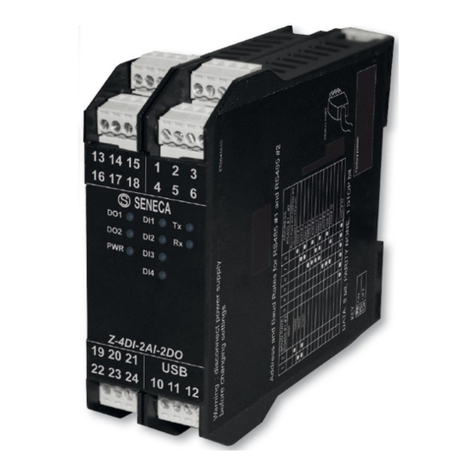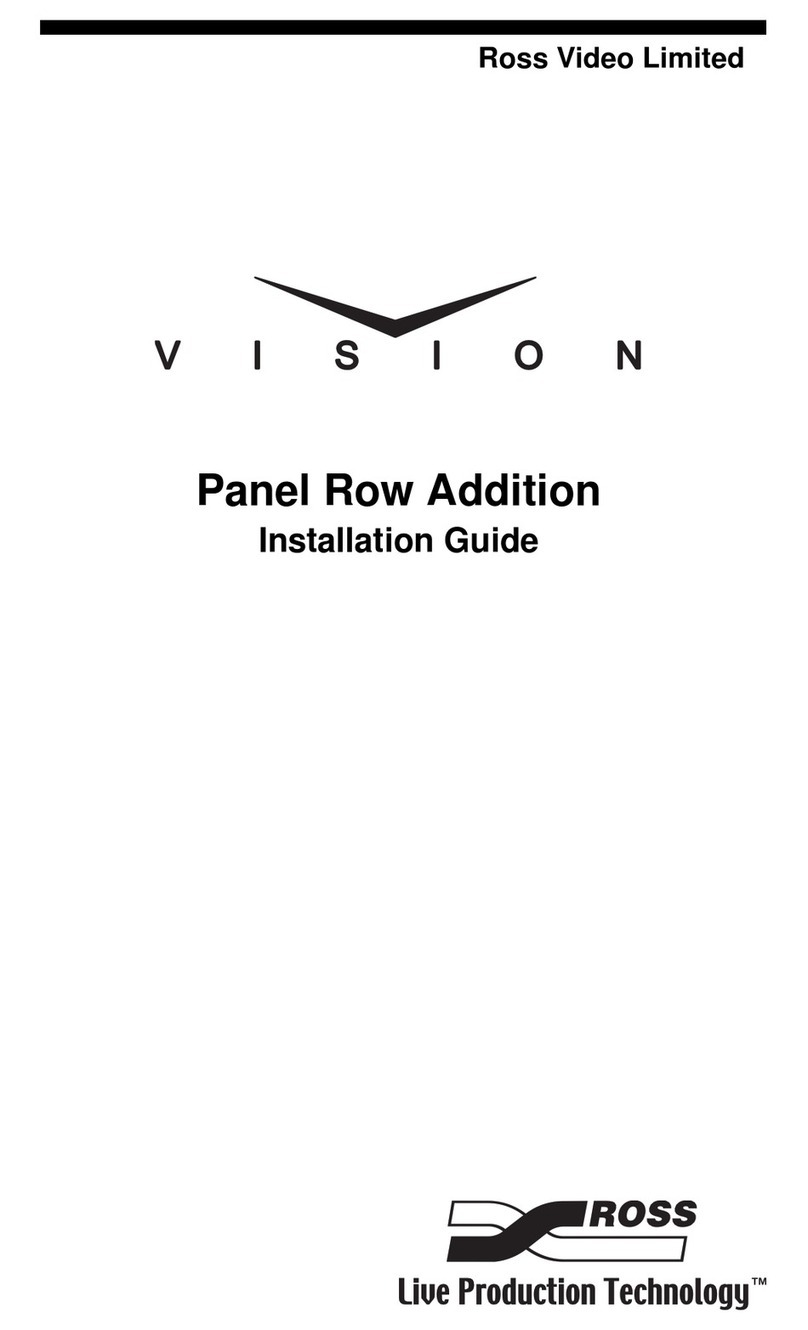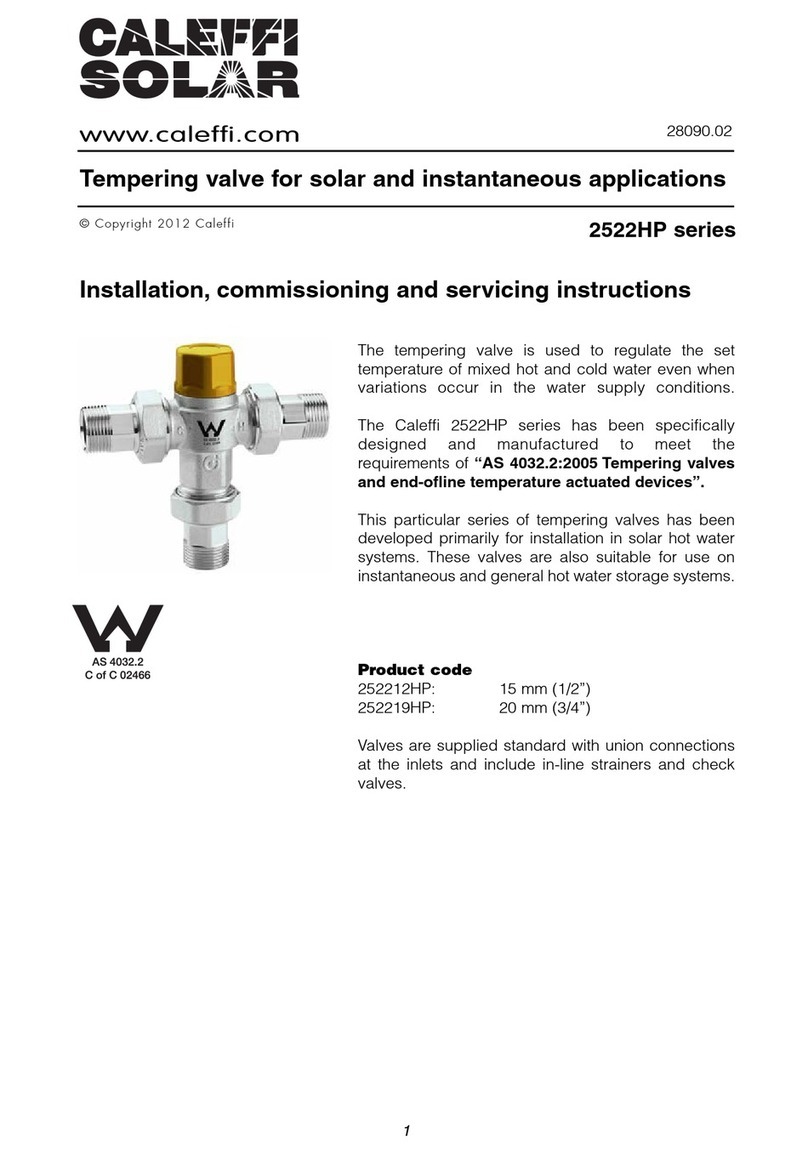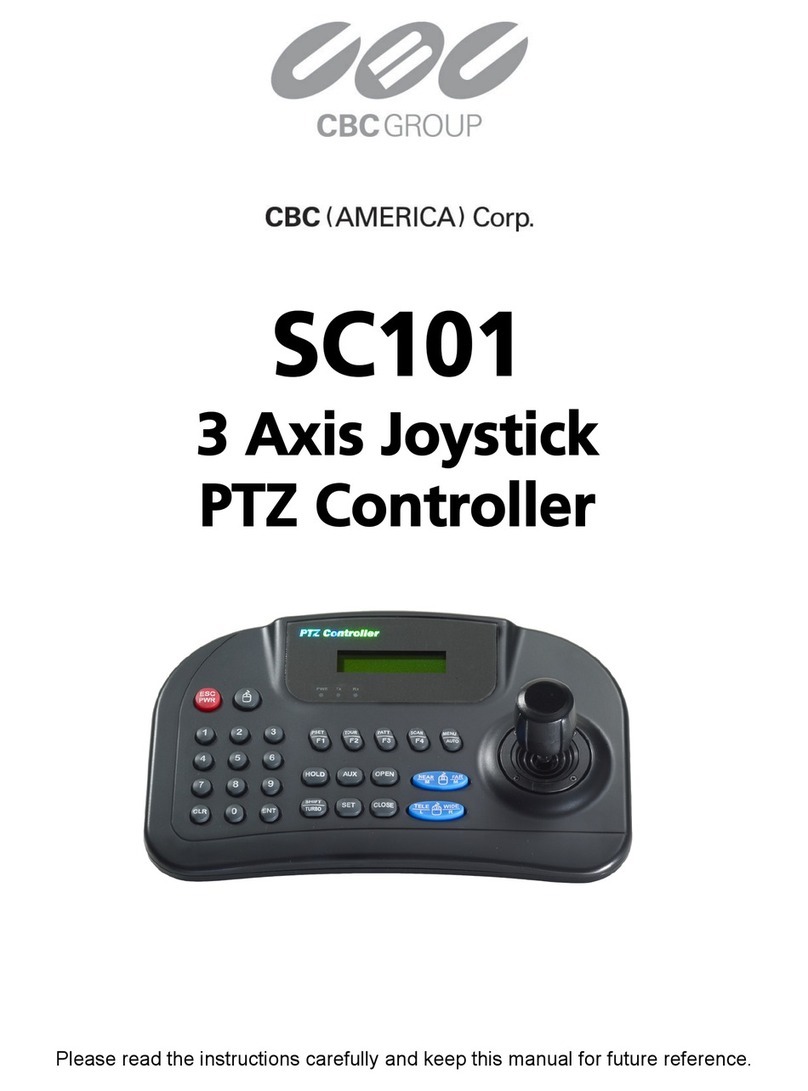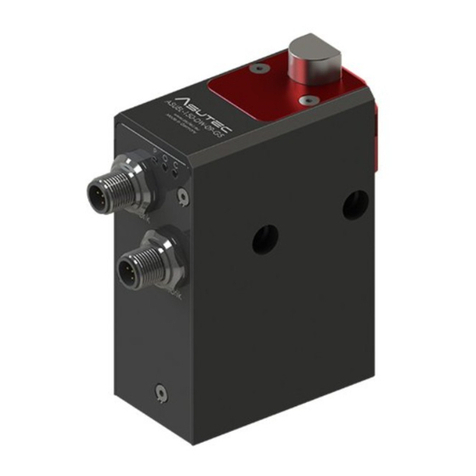
http://www.delta.com.tw/products/plc.asp
DVP-EH DVP04DA-H
Analog Input Module
Instruction Sheet
1 WARNING
Please carefully read this instruction thoroughly prior to use the DVP04DA-H.
The DC input power must be OFF before any maintenance.
This is an OPEN-TYPE built-in DVP04DA-H, and the DVP04DA-H is certified to meet the safety
requirements of IEC 61131-2 (UL 508) when installed in the enclosure to prevent high
temperature, high humidity, exceessive vibration, corrosive gases, liquids, airbome dust or
metallic particles. Also, it is equipped with protective methods such as some special tool or key to
open the enclosure, in order to prevent the hazard to users and damage DVP04DA-H.
Do not connect the AC power to any of the input/output terminals, or it may damage to the
DVP04DA-H. Make sure that all the wiring is well conducted prior to power on.
Do not touch the internal circuit for at least 1 minute after the power supply is OFF.
Make sure that the DVP04DA-H is properly grounded , to prevent any electromagnetic noise.
2 INTRODUCTION
2.1 Model Explanation and Peripherals
Thank you for choosing DELTA’s PLC DVP Series. The analog output module of DVP04DA-H
series can read/write the data of analog output module by using instructions FROM / TO via
DVP-PLC EH Series MPU program. The analog output module receives 12-bit digital data of 4
groups from PLC MPU and converts it into 4 points analog output signal either in voltage or in
current.
Software version of DVP04DA-H analog output module can be updated via RS-485.
Users can select output from voltage or current via wiring. Voltage output range is 0V ~ +10V DC
(resolution is 2.5 mV). Current output range is 0mA ~ 20mA (resolution is 5 µA).
Nameplate Explanation
20.4VDC ~ 28.8VDC
VX.XX 04DA-H0T4130001
0 ~ +10V or -0 ~+20mA
2.5mV or 5 A
Model Name
Input power supply spec.
Analog input/output module spec.
Barcode
Model Explanation
Serial Number
Model
Product Series
Input+Output point
Model type
AD: Analog input module
DA: Analog output module
PT: Platinum temperature sensors(PT-100)
TC: Thermocouple sensors(Type J/K)
S: for SS series MPU
P: for EP series MPU
H: for EH series MPU
Production week
Production place (Taoyuan)
Production year (2004)
Production Model
XA: A/D , D/A Functions
RT: Resistor Thermocouple
HC: High speed count input module
PU: single axis positioning unit
2.2 Product Profile and Outline
Unit:mm
1. DIN rail track (35mm) 6. Terminals
2. Mounting hole for wire to connect extension
unit/extension module 7. Mounting hole
3. Model name 8. Terminal layout
4. Indicator for power, error and run status 9. Mounting port to connect extension
unit/extension module
5. DIN rail clip
2.3 External wiring
V+
I+
COM
V+
I+
COM
24+
24-
DC/DC +15V
-15V
AG
FG
FG
CH1
CH1
0V~+10V
*2
*3 DC24V
CH2 CH2
AC drive, recorder,
scale valve...
AC drive, recorder,
scale valve...
voltage output
shielding cable *1
shielding cable *1
current output
converter
terminal of
power module
system grounding
class 3 grounding
(100 or less)
Note 1: Please isolate analog output and other
power wiring.
Note 2: If the noise interference from loaded wiring
input terminal of is significant, please
connect a capacitor with 0.1~0.47µF 25V
for noise filtering.
Note 3: Please connect terminal of power
module and terminal of analog output
module to system earth point and make
system earth point be grounding or
connects to machine cover.
Warning: DO NOT wire to the No function terminal
●.
3 STANDARD SPECIFICATIONS
3.1 Specifications
Digital/Analog (4D/A) Module Voltage Output Current Output
Power Supply Voltage 24 VDC(20.4VDC~28.8VDC) ( –15%~+20%)
Analog Output Channel 4 channels / each module
Analog Output Range 0~10V 0~20 mA
Digital Data Range 0~4000 0~4000
Resolution 12 bits (1LSB=2.5 mV) 12 bits (1LSB=5 µA)
Output Impedance 0.5Ωor lower
Overall Accuracy ±0.5% of full scale of 25℃(77℉)
±1% of full scale during 0~55℃(32~131℉)
Response Time 3 ms ×channels
Max. Output Current 20 mA(1KΩ~2MΩ) -
Tolerance Carried Impedance -0〜500Ω
Digital Data Format 2’s complementary of 16-bit, 13 Significant Bits
Isolation Method It has isolation between digital area and analog area. There is no
isolation among channels.
Protection
Voltage output has short circuit protection but short circuit for a long
period short circuit may cause inner wiring damage and current
output break.
Communication mode (RS-485)
Yes, there are ASCII/RTU modes, communication rate can be 4800
/9600 /19200 /38400 /57600 /115200. Communication format of
ASCII mode is 7Bit, even bit, 1 stop bit (7 E 1). Communication
format of RTU mode is 8Bit, even bit, 1 stop bit (8 E 1). Can’t use
RS-485 if PLC MPU connection is in series.
Connect to DVP-PLC MPU in
series
If DVP04DA-H modules are connected to MPU, the modules are
numbered from 0 – 7. 0 is the closest and 7 is the furthest to the
MPU. 8 modules is the max and they do not occupy any digital I/O
points of the MPU.
3.2 Other Specification
Power Specification
Max. Rated Consuming Power 24 VDC (20.4VDC~28.8VDC) (–15%〜+20%), 2W, supply from
external power
Environment Condition
Environment Condition Follow the DVP-PLC MPU
Spec. of Prevent Static
Electricity All places between terminals and ground comply with the spec
4 CR (Control Register)
DVP04DA-H Analog Output Module Explanation
CR
No.
RS-485
Parameters
Address
Latched Register Name b15 b14 b13 b12 b11 b10 b9 b8 b7 b6 b5 b4 b3 b2 b1 b0
#0 H 4032 ○R Model type System used, DVP04DA-H model code=H 0401
Reserved CH4 CH3 CH2 CH1#1 H 4033 ○R/W Output mode setting
Output mode setting: factory setting is H0000.
Mode 0: output voltage mode (0V~10V).
Mode 1: output voltage mode (2V~10V).
Mode 2: output current mode (4mA~20mA).
Mode 3: output current mode (0mA~20mA).
Mode 4: none use.
#2 ~ #5 Reserved
DVP04DA-H Analog Output Module Explanation
CR
No.
RS-485
Parameters
Address
Latched Register Name b15 b14 b13 b12 b11 b10 b9 b8 b7 b6 b5 b4 b3 b2 b1 b0
#6 H 4038 ○R/W CH1 output value
#7 H 4039 ○R/W CH2 output value
#8 H 403A ○R/W CH3 output value
#9 H 403B ○R/W CH4 output value
The output setting range of channel CH1~CH4 is K0~K4000. Factory setting is K0
and unit is LSB.
#10~#17 Reserved
#18 H 4044 ○R/W To adjust OFFSET
value of CH1
#19 H 4045 ○R/W To adjust OFFSET
value of CH2
#20 H 4046 ○R/W To adjust OFFSET
value of CH3
#21 H 4047 ○R/W To adjust OFFSET
value of CH4
It is used to set the OFFSET value of CH1~CH4. The setting range is
K-2000~K2000. The factory setting is K0 and unit is LSB.
#22 ~ #23 Reserved
#24 H 404A ○R/W To adjust GAIN
value of CH1
#25 H 404B ○R/W To adjust GAIN
value of CH2
#26 H 404C ○R/W To adjust GAIN
value of CH3
#27 H 404D ○R/W To adjust GAIN
value of CH4
It is used to set the GAIN value of CH1~CH4. The setting range is K-1600~K8000.
The factory setting is K2000 and unit is LSB.
#28~#29 Reserved
#30 H 4050 ╳R Error status Data register used to save all error status. Please refer to fault code chart for details.
#31 H 4051 ○R/W Communication
address setting
It is used to set RS-485 communication address. The setting range is from 01 to 255
and the factory setting is K1.
#32 H 4052 ○R/W Communication
Baud Rate setting
It is used to set communication baud rate (4800, 9600, 19200, 38400, 57600,
115200bps). Communication format: ASCII mode is 7Bit, even bit, 1 stop bit (7 E 1).
Communication format of RTU mode is 8Bit, even bit, 1 stop bit (8 E 1).
b0: 4800 bps (bit/sec). b1: 9600 bps (bit/sec). (factory setting)
b2:19200bps(bit/sec). b3:38400bps(bit/sec).
b4: 57600 bps (bit/sec). b5: 115200 bps (bit/sec).
b6-b13:reserved.
b14: exchange low and high byte of CRC check code (only for RTU mode)
b15: ASCII / RTU mode selection
b15 b14 b13 b12 b11 b10 b9 b8 b7 b6 b5 b4 b3 b2 b1 b0
Reserved CH4 CH3 CH2 CH1
#33 H 4053 ○R/W Reset to factory
setting and set
characteristics
adjustable priority
Factory setting H0000.
Give CH1 setting for example:
1. When b0=0, user can set OFFSET and GAIN value of CH1 (CR#18, CR#24).
When b0=1, inhibit user to adjust OFFSET and GAIN value of CH1 (CR#18,
CR#24).
2. b1 means if characteristic register is latched. b1=0 (factory setting, latched), b1=1
(not latched).
3. When b2 is set to 1, all settings will reset to factory setting.
#34 H 4054 ○R Software version. It is hexadecimal to display software version. For example: H 010A means 1.0A.
#35~#48 System used
○means latched.
╳means not latched.
R means can read data by using FROM instruction or RS-485.
W means can write data by using TO instruction or RS-485.
LSB (Least Significant Bit): 1. Voltage output: 1LSB=10V/8000=2.5mV. 2. Current output: 1LSB=20mA/4000=5µA.
Explanation:
1. The content of CR#0 is model type, user can read the data from program to know if there is extension
module.
2. CR#1 is used to set two inner channels working mode of analog output module. Every channel has
four modes to set and can be set individually. For example: if setting CH1 to mode 2 (b2~b0=010),
CH2 to mode 1(b5~b3=001). It needs to set CR#1 to H000A. The factory setting of CR#1 is H0000.
3. CR#2 ~ CR#5, CR#10 ~ CR#17, CR#22, CR#23, CR#28, CR#29 Reserved.
4. CR #6 ~ CR#9 display CH1~CH4 output signal. The setting range is K0~K4000. Factory setting is K0
and unit is LSB.
5. CR#18 ~ CR#21 means the value of adjusting OFFSET value of CH1~CH4. The factory setting is K0
and unit is LSB. If output value equal to 0 after calculating, the adjustable range of analog output
voltage or current is -2000~+2000.
Voltage adjustable range: -5V~+5V(-2000LSB~+2000LSB).
Current adjustable range: -10mA~+10mA (-2000LSB~+2000LSB).
6. CR#24 ~ CR#27 means the value of adjust GAIN value of CH1~CH4. The factory setting is K2000 and
unit is LSB. If output value equal to 2000 after calculating, the adjustable range of analog output
voltage or current is -1600~+8000.
Voltage adjustable range: -4V~+20V(-1600LSB~+8000LSB).
Current adjustable range: -8mA ~+40mA (-1600LSB~+8000LSB).
Please be noticed that GAIN VALUE – OFFSET VALUE = +400LSB ~+6000LSB (voltage or current). If the
value difference comes up small (within range), the output signal resolution is then slim and the
variation is definitely larger. On the contrast, if the value difference exceeds the range, the output
signal resolution becomes larger and the variation is definitely smaller.
7. CR#30 is fault code. Please refer to the following chart.
Fault Description Content b15~b8 b7 b6 b5 b4 b3 b2 b1 b0
Power Source Abnormal K1(H1) 0 0 0 0 0 0 0 1
Analog Input Value Error K2(H2) 0 0 0 0 0 0 1 0
Setting Mode Error K4(H4) 0 0 0 0 0 1 0 0
Offset/Gain Error K8(H8) 0 0 0 0 1 0 0 0
Hardware Malfunction K16(H10) 0 0 0 1 0 0 0 0
Digital Range Error K32(H20) 0 0 1 0 0 0 0 0
Average Times Setting Error K64(H40) 0 1 0 0 0 0 0 0
Instruction Error K128(H80)
Reserved
1 0 0 0 0 0 0 0
Note: Each fault code will have corresponding bit (b0~b7). Two or more faults may happen at the same time. 0
means normal and 1 means having fault.
8. CR#31 is used to set RS-485 communication address. The setting range is from 01 to 255. The factory
setting is K1.
9. CR#32 is used to set RS-485 communication baud rate: 4800, 9600, 19200, 38400, 57600, 115200



